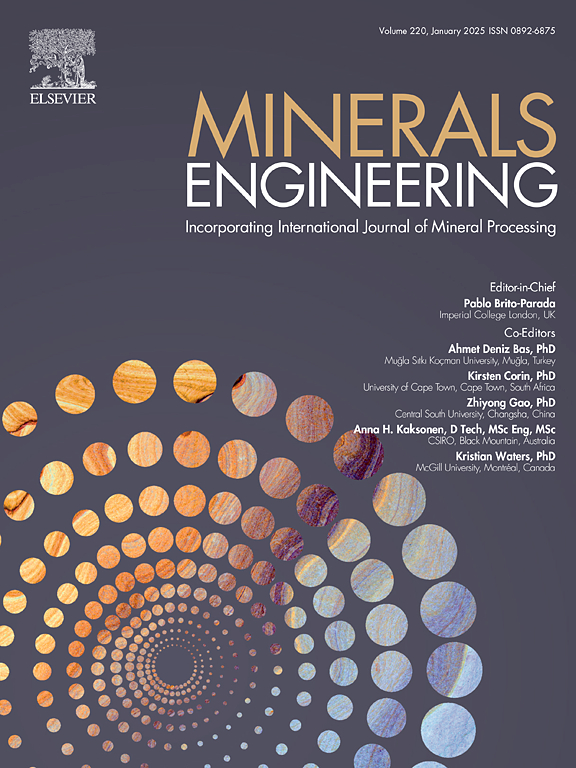Sustainable production of rare earth elements by recycling NdFeB magnets through sulfation chemistry assisted water leaching process
IF 4.9
2区 工程技术
Q1 ENGINEERING, CHEMICAL
引用次数: 0
Abstract
This study presents a comprehensive kinetic and experimental analysis of selective sulfation roasting of spent NdFeB magnets using Fe2(SO4)3, followed by water leaching, to optimize the recovery of rare earth elements. The activation energy for the sulfation reaction was determined to be 205.9 kJ/mol, with the dominant mechanism function aligning with 1-(1-α)2/3, indicating that the process was typically controlled by interfacial chemical reactions at the surface of the unreacted core. Key parameters including temperature, roasting duration, and Fe2(SO4)3 dosage were systematically varied to identify optimal conditions for sulfation roasting and metal leaching efficiency. Under the optimized conditions (i.e., a roasting temperature of 700 °C, roasting time of 240 min, and a nFe2(SO4)3:n(RE + Fe) molar ratio of 2:1), leaching efficiencies of 96.4 %, 98.7 %, and 87.6 % were achieved for Nd, Pr, and Gd, respectively, while Fe leaching remained minimal at 0.01 %. The leaching residue was rich in hematite (Fe2O3), suitable for applications in iron and steel production.
硫酸化学辅助水浸法回收钕铁硼磁体可持续生产稀土元素
采用Fe2(SO4)3对废钕铁硼磁体进行选择性硫酸焙烧,然后进行水浸,以优化稀土元素的回收,并进行了综合动力学和实验分析。磺化反应的活化能为205.9 kJ/mol,主要机理函数为1-(1-α)2/3,表明该过程主要受未反应核表面的界面化学反应控制。系统地改变了温度、焙烧时间、Fe2(SO4)3投加量等关键参数,确定了硫化焙烧和金属浸出效率的最佳条件。在焙烧温度为700℃、焙烧时间为240 min、nFe2(SO4)3:n(RE + Fe)摩尔比为2:1的优化条件下,Nd、Pr和Gd的浸出率分别为96.4%、98.7%和87.6%,而Fe的浸出率最低,为0.01%。浸出渣中含有丰富的赤铁矿(Fe2O3),适合用于钢铁生产。
本文章由计算机程序翻译,如有差异,请以英文原文为准。
求助全文
约1分钟内获得全文
求助全文
来源期刊

Minerals Engineering
工程技术-工程:化工
CiteScore
8.70
自引率
18.80%
发文量
519
审稿时长
81 days
期刊介绍:
The purpose of the journal is to provide for the rapid publication of topical papers featuring the latest developments in the allied fields of mineral processing and extractive metallurgy. Its wide ranging coverage of research and practical (operating) topics includes physical separation methods, such as comminution, flotation concentration and dewatering, chemical methods such as bio-, hydro-, and electro-metallurgy, analytical techniques, process control, simulation and instrumentation, and mineralogical aspects of processing. Environmental issues, particularly those pertaining to sustainable development, will also be strongly covered.
 求助内容:
求助内容: 应助结果提醒方式:
应助结果提醒方式:


